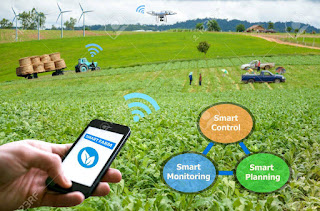In recent years every other novel innovation is invented to make a system SMART. In agriculture also all the recent innovation is related to IoT which is the technique with which we are converting a conventional farm into a "Smart Farm".In case of smart firms there are five essential factors which is important for making a farm "SMART". The three factors are :
1)Farm management
Farm management is the collective term for numerous management strategies and methods that are applied to maintain a farm thriving and rewarding. Even among farms, the procedures will vary relying on the form of farming business included and the size of the operation as a whole. (https://www.farmmanagement.pro/what-is-farm-management/)
2)Tasks management and planning:
There are a pair of elements in the handling of irrigation projects. One is the combined management function, which has much in common in any administration of any other kind of organization. It is apprehensive with the direction and coordination of the decision-making processes within the project area, and its purpose is to get all those involved in the process (farmers, staff, external government agencies) to work towards the accomplishment of the project's objectives.
The remaining element is the management of specialized activities like water distribution, maintenance, irrigation assistance services etc. which are particular to irrigation projects. These techniques have specific characteristics which require particular kinds of management skills and deign of operation.
Both supply and demand data can be compiled to estimate the probabilities of reconciliation in the objectives and choices of different interest groups - farmers, irrigation officials, agricultural officials, higher-level government agencies - to reach agreement on the forthcoming seasonal plan. The required adjustment in the interest of equatable water distribution, motivating staff (through rewards and sanctions) to resist pressures from farmers to mis-allocate water; also rewarding farmers for good watercourse operation and maintenance and punishing them for misappropriations. the development of easy information and control systems with clearly-defined criteria of performance and suitable objective indicators can be monitored and accordingly the process can be adjusted through :
i)Planning
ii)Execution
iii)Monitoring
3)Hydro-Climatic Factors:
The availability and convenience in acquiring the required water resources mainly depends on climate and environment of the area. The unevenness in rainfall and temperature has obvious impact on stream flow level and time of hydrologic events. As for example the factors of environment and hydrology can be enlisted as below :
i)Rainfall
ii)Runoff,
The rate and quantity of runoff are generally required for the design of drains, canals and other channels, prediction of water levels in streams and rivers and when storage is involved for irrigation, power generation, river transport etc. the approximation must include annual or longer-term variations, minimum yield and reliability.
Quality of runoff is increasingly a matter of concern due to chemical pollution from health and environmental aspects; sedimentation, because of interference with drainage, land use, irrigation and power generation and degraded quality of runoff will degrade the quality of yield. A high pH runoff can make a field alkaline and the low pH will made it acidic.Both of which is unsuitable for a healthy yield of healthy and common crops.
That is why this factor need to predicted,simulated and optimized to develop a smart farm management plan.
4)Erosion or Soil loss:
Estimating soil loss is especially complicated because there are multiple variables on which soil erosion changes. As a result, models, whether empirical or process-based, are necessarily complex if they are to include the effects of all variables.The Universal Soil Loss Equation(USLE) will shortly be replaced by the Revised Universal Soil Loss Equation (RUSLE), which is comparable with the previous equation of soil loss estimation but with more advanced inputs and designed for operation on personal computers.
In recent years, there has been a expansion of mathematical simulation models, based on the various physical processes involved in soil detachment, transportation and deposition. Most have unrealistic titles constructed to provide an unpronounceable acronym. The complexity of the erosion process, and the need for huge data banks to compile the many algorithms which are included in the models, mean that most of this type of model requires a powerful mainframe computer.
Amount of soil loss is another important factor which need to be recorded, estimated and optimized to create a smart farm management plan as more loss in soil will make the field less cultivable.
5)Sediment Transport
Sediment movement in streams and rivers takes two forms. Suspended sediment is the finer particles which are held in suspension by the eddy currents in the flowing stream, and which settle out only when the stream velocity decreases, such as when the stream gradient flattens, or the stream discharges into a pond or lake. Larger particles are rolled along the stream-bed and form the bed-load. When a farm takes the water from a stream or river for irrigation the quality of yield among many other factors also depend on the presence of suspended solids in irrigation water. Larger the concentration less preferred is the water for application as the suspended materials can choke the soli pores and reduce the aeration in the soil layers which is required for a healthy cultivation.That is why one of the major drivers of smart farm is to monitor and predict the sediment transport of the stream or river which is treated as the source of irrigation.
To make a farm smart one has to controle,predict and monitor the variations in these five factors which are the five pillars of intelligent farms.
Thanking you,
Founding Editor
Innovate with Sustainability
Group : The Water,Energy and Informatics Groups

